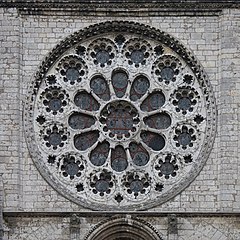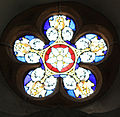Lots of fun

In architecture, multi- pass is often used to denote jagged round or semicircular decorative shapes, which occur primarily in tracery , but sometimes also in the framing of windows and in arches . The five-pass and the six-pass are the simplest forms of the multi-pass, whereas the three-pass and four-pass are not counted as multi-passes.
history
Many passes are unknown in ancient architecture and ornamentation; they are probably creations of Islamic architecture . The medieval architects and stonemasons of Central Europe rarely used such forms - unlike three or four passes; they were mainly reserved for representative sacred buildings .
Multi-pass window and multi-pass framing
Larger multi-pass windows or glare windows are often designed as wheel windows ; smaller ones are extremely rare. The frame of a window can also be shaped as a polychrome.
Window in Chirbat al-Mafjar , around 740
Five-pass window at the collegiate church of Ossiach , Carinthia
Six-pass window at Heiligenkreuz Abbey , Lower Austria
Multi-pass frame of a round window in Puebla de Sanabria , Castile-León
Multi-pass bows
Halving a multi-pass results in multi-pass arcs that are open at the bottom; one also speaks of " zigzag " or "fan arcs". In the Islamic - Moorish art of Andalusia they appear very early and often (e.g. in the mosque of Cordoba ); later they experience a true heyday in the palaces of Al-Andalus (e.g. Aljafería Palace of Saragossa , Alhambra of Granada or Alcázar of Seville ). They can also be found in Islamic art in India as early as the 13th century (e.g. mihrab niche in the mausoleum of Iltutmish , Delhi ); later they become a characteristic architectural element of Mughal architecture in both mosques and palace buildings . In the European Middle Ages, they are more common in some regions of southern and central Europe - especially in the Romanesque style period (e.g. in the north of the Iberian Peninsula or in the southern half of France). They can even be found sporadically in the Norman architecture of England: B. in the portal of Lichfield Cathedral .
Mosque of Cordoba
(8th century)Romanesque portal of the Church of Duratón
(12th century)Romanesque portal of the church of Ainay-le-Château (12th century)
literature
- Günther Binding : tracery . Scientific Book Society, Darmstadt 1989, ISBN 3-534-01582-7
- Leonhard Helten : Medieval tracery. Origin - Syntax - Topology . Reimer, Berlin 2006, ISBN 3-496-01342-7 .
- Lottlisa Behling : Shape and history of the tracery (= Die Gestalt. H. 16, ZDB -ID 532755-6 ). Niemeyer, Halle (Saale) 1944, (2nd, expanded edition. Böhlau, Cologne et al. 1978, ISBN 3-412-03077-5 ).










